One of the most reliable methods for tooth replacement is dental implants. In America alone, more than 3 million implants are placed by dentists each year—and that figure is on the rise.
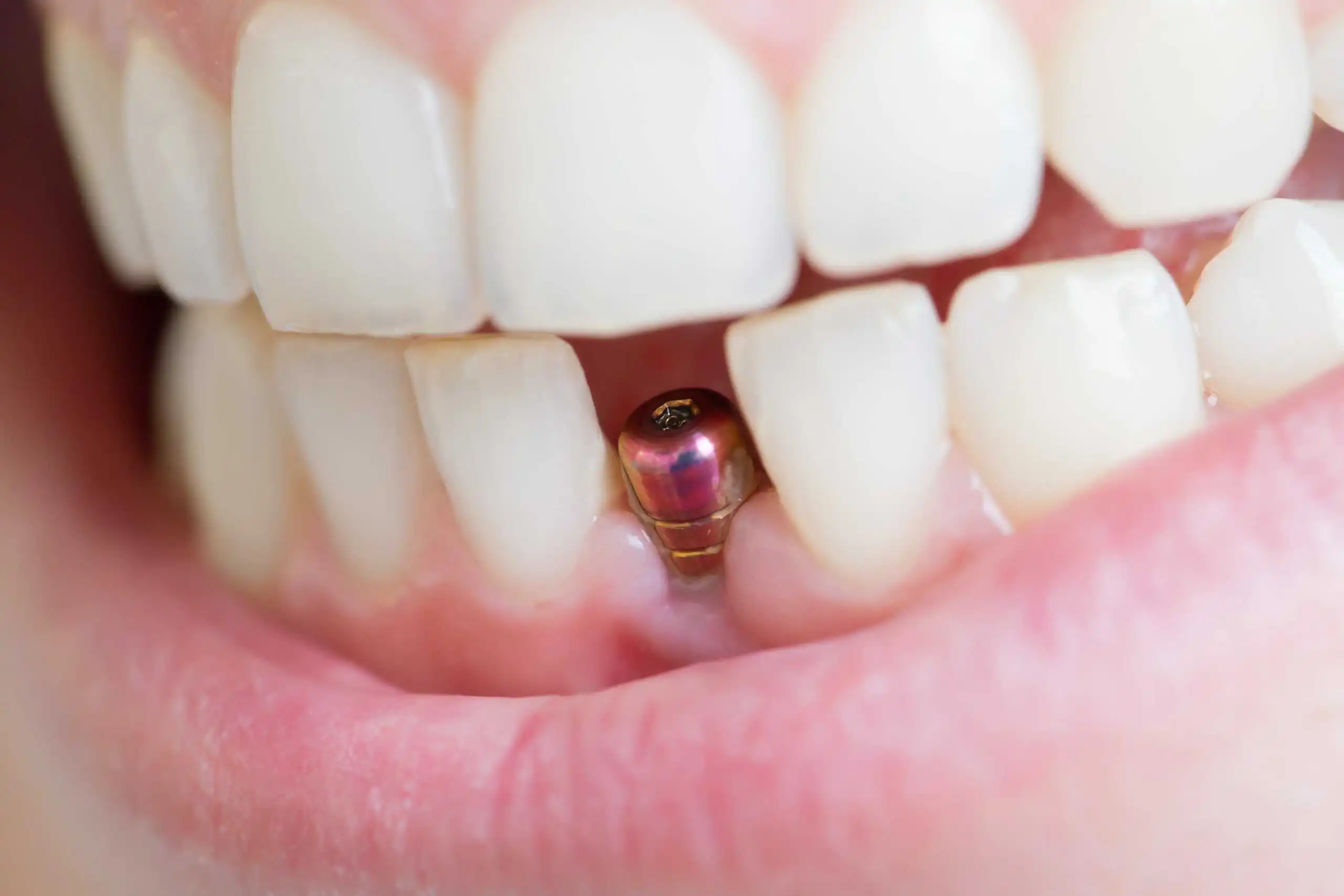
These are strong, durable, and mimic natural teeth. However, an implant is not a quick fix. Healing takes time, and each stage is important for success.
We will take you step by step through the process of healing after implant surgery—what you should anticipate, how long it will take, and what to watch out for.
Understanding Dental Implants
Dental implants are tiny, screw-type posts either made of titanium or ceramic. The post is inserted into your jawbone, where it functions as a natural root. Your bone will eventually bond with the implant in a process referred to as osseointegration. This establishes a solid, stable foundation for your new tooth. [1]
Implants benefit more than your smile. Implants make chewing better, keep your jawbone from shrinking, and preserve other teeth from moving out of position. Implants also don’t use adjacent teeth for support like fixed bridges do. [2]
What is the Dental Implant Surgery Process?
Getting an implant is not a single-step process. Here is how it is done step by step:
Initial Assessment
Before you have a dental implant, one of our dentists will first ensure that it is safe and suitable for you. This begins with a consultation. Your dentist will question you about your history, examine your mouth, and discuss any medications you’re on.
The key objective is to ensure:
- You are fit enough for surgery.
- Nothing in your health would impede healing.
- Your lifestyle (such as smoking) will not influence outcomes.
- If you have gum disease or any other oral problem, these should be addressed first.
Who Might Not Be a Good Fit for Implant Surgery?
Certain health concerns may complicate implant surgery. However, this may not always mean that implants are impossible. In some cases, your dentist may only need to coordinate with your physician or modify the plan.
These are some relative contraindications to the surgery that may pose concerns: [3]
- Gum diseases
- Poor diet or smoking
- Heart disease
- Cancer or blood disorders
- Diabetes
- Blood thinners
- High blood pressure
- Bone loss
- Liver disease
- Bruxism (teeth grinding)
How Do You Prepare for Dental Implant Surgery?
Preparing for dental implant surgery involves some planning. Several different specialists may participate in your care, depending on what you need. These may include Oral surgeons, Periodontists, Prosthodontists, and ENT specialists.
What happens before surgery?
You will have a few steps to complete to ensure everything is safe and in its proper position:
- Dental examination: You can have X-rays or 3D scans to get a clear view of your jaw and teeth.
- Medical evaluation: Your health, as well as medications or supplements you may take, will be discussed with your dentist. In certain situations, you may require preoperative antibiotics to avoid infection.
- Personalized treatment plan: This is created exclusively for you. What it will take into account is how many teeth you have put in and how healthy your jaw and gums are.
Pain Management Options
You will not have pain during surgery, but how it’s controlled can depend on:
- Local anesthetic: Prevents pain. You are conscious. [4]
- Sedation: Keeps you calm and relaxed.
- General anesthetic: You will be asleep.
Discuss with your dentist what is best for you.
Before The Big Day
- Avoid eating or drinking anything for a few hours when you’re having sedation or general anesthesia.
- Arrange to have a driver take you home.
- Relax and plan on resting afterward.
Dental Implant Installation Stages
Getting implants is not a day’s work. It’s a process that occurs over several months in stages. [5]
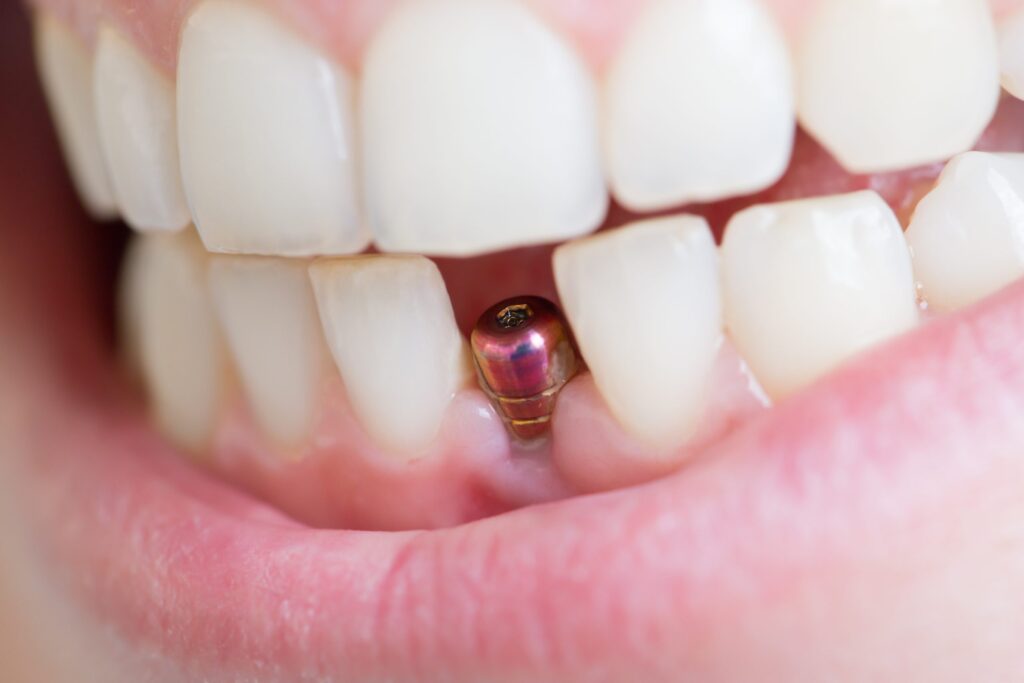
Here is a basic outline of what is done step by step:
Stage 1: The Surgical Stage – Implant Placement
This is where the implant is inserted into the jawbone. It is a relatively minor procedure, most often performed at your dentist’s or oral surgeon’s facility.
This is what typically occurs at this phase:
- You will first receive anesthesia to numb your mouth. This may be local anesthesia, sedation, or general anesthesia, depending on your condition.
- After numbing and making you comfortable, the dentist will then make an incision in the gum to expose the bone.
- Next, there is a tiny hole drilled in the jawbone. This is carried out delicately.
- The implant, a tiny screw made out of titanium, is inserted into that hole.
- The gum is then stitched shut to assist with healing afterward.
If your implant is at the front of your mouth, you may receive a temporary tooth to wear while you’re healing, with no gap in sight. For implants placed at the back, no temporary tooth is typically required.
Stage 2: The Healing Stage – Osseointegration
This is the part where your body takes over. Once implanted, your jawbone will begin growing around it. This is referred to as osseointegration. [6]
The bone integrates with the implant, securing it as firmly as a root on a natural tooth. It is most critical at this level. It will typically take 3 to 9 months, but it may take longer in some individuals.
Throughout this period:
- You may be instructed to have soft foods and not apply pressure to the implant.
- Follow your dentist’s care instructions very closely.
- You might have a little pain when chewing, sleeping, or speaking for several days.
- You will have routine check-ups to ensure implant healing is going as it should.
- Good oral health is vital at this stage. Keep it clean and refrain from smoking, as this can retard healing.
Stage 3: Placing the Abutment
After healing is complete and the implant has stabilized, the next step is to secure the abutment. The abutment is a little connector. It attaches to the implant and secures the final crown, bridge, or denture.
The abutment is sometimes placed at the initial surgery. At other times, it’s positioned afterward by having a second small surgery in which the dentist opens your gum again to secure it.
It will take a couple of weeks for your gums to heal afterward.
Stage 4: Restoration Stage – Placing the New Tooth
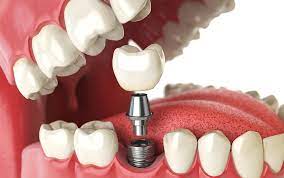
The best part now is the new tooth! Once your gums have healed, your dentist will:
- Make an imprint of your implant and teeth.
- Use them to create the final crown, bridge, or denture. It will blend with other teeth in shape and color.
- Secure the final restoration on the abutment.
- This process typically lasts around an hour, and this completes it.
Pain After Dental Implant Surgery
It’s absolutely normal to have some pain or discomfort once a dental implant has been put in. Mild pain, swelling, or bruising in the treated area is experienced by most people. This is typically only for a day or two following surgery and resolves eventually with rest and proper care.
Your dentist will provide you with directions on how to handle pain. You will most likely be instructed to take painkillers such as ibuprofen or paracetamol over-the-counter. In certain cases, prescription drugs may be provided—particularly when several implants are inserted or when surgery is more involved.
How Long Do Dental Implants Take to Heal?
Healing from implant surgery is gradual. Although you will likely improve within a few days, complete recovery will take much longer.
During the first week, your gums will start to heal, and pain or swelling will settle down. More profound healing occurs over the few months that follow. This is when your jawbone integrates with the implant through osseointegration. This is a critical step. It’s what provides the implant with strength, stability, and long-term success.
Average Recovery Time:
- Initial recovery: 5 to 7 days (gum recovery and pain relief)
- Osseointegration: 9 to 3 months (bone integrates with implant)
- Final restoration: The final crown, bridge, or denture will be fitted by your dentist once the implant is secure.
The whole process may take as long as 12 months in some instances. This may sound like a long process, but it makes sure that the implant is fully integrated as a strong and stable part of your mouth.
What Not to Do After Dental Implant Surgery?
Your mouth has to heal after having a dental implant. To help your implant settle in properly and avoid problems, here’s what you should avoid:
- No heavy activity: Rest for at least a few days. Do not run, gym workouts, lift heavy objects or engage in sports with physical contact.
- Don’t touch the area: Avoid poking at the implant area with your tongue or with your fingers. Allow it to rest.
- Avoid hard or sticky foods: Opt for soft foods such as yogurt, mashed potatoes, soups, and smoothies, particularly during the initial week.
- Don’t miss taking medicine: Unless instructed otherwise by your dentist, take painkillers or antibiotics.
- Don’t forget oral hygiene: Follow the routine as advised by your dentist, being careful in the area near the surgery.
- No smoking or drinking: Drinking alcohol may irritate your mouth and interfere with some medications. Avoid them both—particularly in the first two weeks.
Single Tooth Implant Process
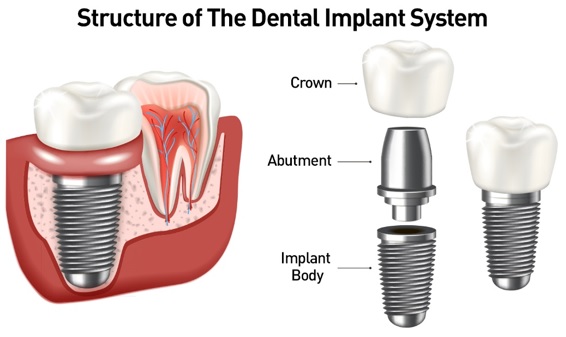
One tooth implant restores one missing tooth. It’s a three-stage process where an implant is inserted into the jaw, and a crown (a new tooth) is bonded to it. The new tooth functions just like your natural ones, so you can eat, talk, and smile as you would like.
This is faster and less complicated than having implants for an entire mouth’s worth of teeth. Here’s how it breaks down:
Case 1: Implant Without Tooth Extraction
Timeline: 3 to 6 months
If your tooth has already been missing, then the process can immediately start as long as you’re a suitable candidate.
Stage 1: Implant Placement
- Numb: Your dentist will numb the area first with a local anesthetic.
- Making the incision: Your dentist will create a little cut in your gum to reveal the bone.
- Placing the implant: A hole is made in the bone, and an implant is inserted into it.
- Stitching the wound: Your gum will get stitched back together, and you’ll have to let it heal for 3-6 months.
Stage 2: Abutment Placement
Once the implant has bonded with the bone, you’ll require a follow-up minor surgery to install the abutment. This process will take 1–2 weeks to heal, and an impression or scan will be taken by your dentist to make the crown.
Stage 3: Dental Crown Placement
- Making the crown: Your dentist will use impressions to have a laboratory make your personalized crown.
- Final placement: The dentist will then screw in your crown once it is finished. This finishes off the job!
Case 2: Dental Implant with Extraction
In this case, one or more decaying or damaged teeth are likely to require extraction. A bone grafting will also have to take place if there is not sufficient bone in the jaw to hold an implant. Bone grafting is when bone is added where bone density is low, making it possible for the implant to securely hold.
Stage 1: Bone Extraction and Grafting
- The Tooth Extraction Process: The first step involves removing the rotten or damaged tooth. The area is numbed with local anesthetic to avoid pain during the process.
- Bone Grafting: Bone grafting is then performed post-extraction. This is mandatory in cases where patients have inadequate jawbones. The bone material may also be taken from other areas within one’s own body or may involve synthetic bone substitutes.
- Healing Time: The bone graft takes 3 to 6 months to heal completely. The new bone is then integrated into the jawbone, forming a solid foundation.
Stage 2: Implant Placement
After healing has occurred with the graft, the next process is inserting a dental implant post (a titanium screw or other such material) into the jawbone.
- Procedure: A tiny incision is made in the gum, and an implant is inserted into the bone. The gum is closed, and healing starts.
- Healing Process: The implant must then osseointegrate with the jawbone, a process that will usually take 3 to 6 months, depending on how quickly an individual heals and on bone quality.
Stage 3: Abutment Placement
The dentist will later attach a small connector referred to as an abutment to the implant once it has bonded with the bone.
- Healing Period: The gum tissues at the abutment area will require healing for 1 or 2 weeks before a final crown is cemented.
Stage 4: Placement of Dental Crowns
After the gum has healed, an impression is made of your teeth in order to fabricate a personalized crown.
Then a crown is created to match the size, shape, and color of your natural tooth. A temporary crown is sometimes fitted in the meantime.
- Final Placement: After the permanent crown is ready, the dentist will secure it onto the abutment either by cementing or screwing it into place.
- Total Healing Time: The entire process from extraction to the final placement of the crown can take 8-12 months, depending on how quickly the bone graft heals and the implant fuses with the jawbone.
Case 3: Immediate Load Implant
Timeframe: 3 to 6 months
This is a quicker alternative where the tooth is extracted and the implant is inserted at once, and at times, bone grafting is also carried out simultaneously. It’s not for every candidate, but it definitely decreases the total duration of treatment.
Stage 1: Extraction, Bone Grafting, and Implant Placement
The damaged or decaying tooth is removed first. The area is numbed with local anesthesia, and you will not feel anything during the process.
Bone Grafting: Bone grafting will be performed if the bone is too thin or not dense enough to support an implant. This process introduces bone into the bone site where the tooth previously existed and builds jawbone strength.
Stage 2: Abutment Placement
The abutment is then placed 1-2 weeks later. The implant is secured with this little piece to the future crown. The gums will heal for an additional 1-2 weeks around the abutment.
Stage 3: Dental Crown Placement
Once the gum is healed, a dentist will make an impression of your teeth and send it to a lab to create your permanent crown.
The final crown will then be cemented to the abutment once it is ready.
Total Recovery Period: Even though the first couple of steps may take less time, osseointegration still takes 3 to 8 months for the implant and jawbone to fully connect before the final crown is installed. [7]
Healing Timeline for Single Dental Implants (3 Common Cases)
| Stage | No Extraction Needed | With Extraction | Immediate Load Implant |
| Step 1: Initial Consultation | Standard pre-surgery exam | Standard pre-surgery exam | Standard pre-surgery exam |
| Step 2: First Surgery | Implant is placed | Tooth removed and bone grafted | Tooth removed, graft done, and implant placed |
| Healing Time | 3 to 6 months | 3 to 6 months | 3 to 6 months |
| Step 3: Second Procedure | Abutment placed | Implant placed | Abutment placed |
| Healing Time | 4 to 7 days | 3 to 6 months | 4 to 7 days |
| Step 4: Final Restoration | Crown fitted | Abutment placed | Crown fitted |
| Final Wait Time | 4 to 7 days | 4 to 7 days | 4 more days |
| Result | Natural-looking tooth | Same as natural tooth | Immediate function and appearance |
Full Mouth Implant Process
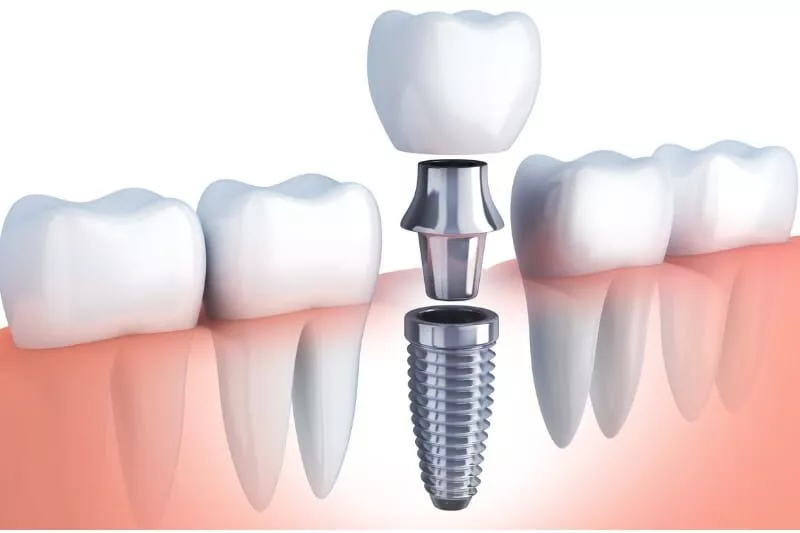
All the teeth in the upper or lower jaw, or both, are substituted by a full-mouth implant surgery. The total number of implants varies in accordance with the case of the patient. [8]
Case 1: Full Mouth Implants With No Extractions
This is an excellent choice for patients with no teeth, denture wearers, or individuals desiring a more permanent answer. This is how it is done:
Stage 1: Placing Implant Posts
The dentist inserts implant posts into the jawbone. The implant posts serve as an anchor for the new teeth. A 3-6 month healing process is required.
Stage 2: Placing Implant Abutments
Following this, once healed, the dentist will then fit small connectors referred to as abutments onto the implants. This will take 1-2 weeks of healing.
Stage 3: Full-Mouth Prosthesis
The last step is an implant-supported prosthesis. This will replace all or most of the jaw’s teeth. It may or may not be removable, depending on what you require. The prosthesis is secured to the abutments and provides you with an operational group of teeth for eating and speaking.
Case 2: Full Mouth Dental Implants with Extractions
This is for individuals with damaged or decayed teeth that require extractions, with implants thereafter. This is slightly more complicated due to extractions and potentially bone grafting involved.
Stage 1: Extractions and Bone Grafting
First, the dentist extracts any teeth that are damaged or decayed. Then, if needed, bone grafting is done to help create a strong foundation for the implants.
Stage 2: Placing Implant Posts
The implants are inserted into the jawbone by the dentist. Recovery takes 3-6 months.
Stage 3: Placing Implant Abutments
Once healed, implants are fitted with abutments. The gums take 1-2 weeks to heal.
Stage 4: Full-Mouth Prosthesis
After placement and healing of the abutments, the full mouth prosthesis is fitted in order to replace all one’s teeth. It may either be removable or fixed.
Case 3: Full-Mouth Immediate Load Implants
This is for individuals requiring all their teeth to be replaced at once, with less healing. There are fewer sessions.
Stage 1: Extractions, Bone Grafting, and Implant Posts Placement
The dentist removes the decayed or damaged teeth, does bone grafting as required, and inserts the implants into the jaw—all in a single surgery.
Stage 2: Implant Abutments Placement
Abutments are positioned on these implants, and a temporary prosthesis is fitted.
Stage 3: Final Prosthesis
After healing for one or two weeks, a permanent prosthesis is fitted on top of or below all the teeth in the jaws.
Timeline for Full Mouth Dental Implants (3 Treatment Cases)
| Treatment Step | No Extractions Needed | Includes Tooth Removal | Immediate Load Option |
| Initial Consultation | Full oral exam and treatment planning | Full oral exam and treatment planning | Full oral exam and treatment planning |
| Stage 1: Surgical Procedure | Implants placed directly | Teeth removed + bone grafts | Teeth removed, grafted, and implants placed together |
| Healing Phase | 3 to 6 months for osseointegration | 3 to 6 months for healing | 3 to 6 months |
| Stage 2: Secondary Procedure | Abutments (connectors) attached | Implants placed | Abutments attached |
| Short Healing Time | 4 to 7 days | 3 to 6 months | 4 to 7 days |
| Final Step: Restoration | Full arch prosthetic fitted | Abutments placed, then prosthetic fitted | Full arch prosthetic fitted |
| Completion Timeframe | About 4 to 7 days after final healing step | Final fitting within 1 week of abutment stage | Immediate appearance and function after fitting |
All-on-4 Dental Implants
All-on-4 is a widely used same-day implant treatment. The entire row of upper or lower jaw teeth is replaced with only four implants, positioned at strategic locations to provide support to a complete set of dentures. The implants are positioned such that there is great support, and this is done in one session. [9]
Zygomatic Implants
Sometimes, zygomatic implants are utilized. These implants are inserted into the cheekbone (zygomatic arch) rather than the jawbone. This is carried out when the jawbone is not strong enough to host normal implants.
Post-Surgery Dental Implant Healing Stages
Healing is critical to maintaining your new smile in its best condition once you have undergone dental implant surgery. Proper care is crucial to maintain long-lasting implants.
Following Implant Placement
Most people opt for local anesthesia for surgery because it’s short. In case you are nervous, you can request sedation. You can drive yourself home with local anesthesia, though, while with sedation, you’ll require someone to drive you.
The First 24 Hours
These are a few things to remember in the first 24 hours following your implant surgery:
- Avoid Spitting and Using Straws
Don’t spit, don’t use a straw, or poke at the surgical area. These will dislodge the forming blood clot and lead to bleeding.
- Bleeding
There will be some slight bleeding that should resolve within 1-2 hours. You should keep some gentle biting pressure on it with gauze. Replace it as often as necessary to stop it from bleeding.
- Swelling
Swelling is to be expected and may be slight or quite obvious. It may actually worsen over the first 1-2 days. You can apply some ice to your face on and off during the day to help reduce swelling.
- Diet
Following an anesthetic, begin with soft, non-irritating foods such as scrambled eggs, or soup. Steer clear of spicy or very hot foods, as these may bother the surgical site.
- Oral Hygiene
Gently brush your teeth while taking special care in areas where you had surgery and follow your doctor’s instructions.
Days Following the Surgery
- Medication
You will be given medicine to control pain. Take it precisely as instructed by the dentist. You will likely take more potent pain medicine every four to six hours for the first 24 hours. Then take something like Tylenol (500 mg) afterward as needed. Narcotics will cause drowsiness, so don’t drive, swim, or drink alcohol.
You will also receive antibiotics. If you have been instructed to take ibuprofen take it every six hours for several days. Call your dentist if the pain persists, or you get ill or have difficulty swallowing the pills.
- Sutures
Your stitches will naturally break down by themselves, typically within a week, though in some cases it may take as long as a week.
- Regular Activities
Take it easy for a while. You can resume work, but don’t do anything very strenuous. Don’t do heavy exercise for at least three days. Gradually get back on your routine.
4 to 6 Months Into the Healing Period
Sometime during this period, your implant will bond with the jawbone. Your mouth should be kept clean, and you should visit the dentist for check-ups. The implant should have some time to heal. Without this, it may not succeed.
All people heal at different rates, based on their individual condition and how they take care of their implants.
After Abutment Placement
The abutment (attachment that joins the crown to the implant) can be tender. This should be resolved within 1-2 weeks. Continue with soft foods until you are comfortable with returning to normal foods.
After Crown Placement
This is quite an easy step. You can have tender gums, but you will be able to eat as usual once the crown has been fitted. There will not be any cuts, so it’s an efficient process.
How Soon Can I Resume Eating as Usual After Implants?
Following dental implant surgery, you will need to follow your dentist’s recommendations. Generally, you will initially have soft foods during the initial few days. This will assist in healing the implant area. Gradually, once swelling and bruising reduce, you can incorporate solid foods into your diet. Give special care while eating near an implant area.
How Long Do Dental Implants Last?
Dental implants are made to last quite a while, sometimes several years or perhaps an entire lifetime. The actual duration may be reliant on several factors such as your oral health, lifestyle, and jawbone health. With adequate care, most people have implants that last more than 20 years or even longer. The crowns on top may need to be renewed eventually, but the implants themselves can remain intact. [10]
What Happens If Your Implants Fail?
In rare cases, dental implants can fail. In this case, notify your dentist immediately. They will analyze the issue and recommend an alternative. In some instances, when an implant becomes loose, it can be removed and replaced.
In cases when it is damaged or fractured, the implant will have to be removed. The dentist will keep a watchful eye on your oral health to identify and take care of any complications. Keep in mind that implants don’t last forever, but with proper care, they may last for several years—often an entire lifetime.
The Bottom Line
Dental implants are a long-term, dependable way to replace missing teeth. Proper care will keep them going for decades or even a lifetime. Regular brushing, flossing, and periodic check-ups will help them succeed. Although failure is rare, it is a possibility. In case an implant does fail, there is always an assessment by your dentist and a suggestion on how to proceed.
In most cases, however, implants provide a long-lasting, natural-appearing alternative that enhances both function and aesthetics, ensuring that you enjoy a healthy, pleasing smile for years to come.
References
- Gupta, Ranjan, et al. “Dental Implants.” PubMed, StatPearls Publishing, 2021, pubmed.ncbi.nlm.nih.gov/29262027/.
- Guillaume, B. “Dental Implants: A Review.” Morphologie, vol. 100, no. 331, Dec. 2016, pp. 189–198, https://doi.org/10.1016/j.morpho.2016.02.002.
- Kullar, Amritpal S., and Craig S. Miller. “Are There Contraindications for Placing Dental Implants?” Dental Clinics of North America, vol. 63, no. 3, July 2019, pp. 345–362, www.dental.theclinics.com/article/S0011-8532(19)30016-3/fulltext, https://doi.org/10.1016/j.cden.2019.02.004.
- Ito, Takaya, et al. “Considerations for Satisfactory Sedation during Dental Implant Surgery.” Journal of Personalized Medicine, vol. 13, no. 3, 1 Mar. 2023, pp. 461–461, https://doi.org/10.3390/jpm13030461. Accessed 28 Apr. 2024.
- Handelsman, M. “Surgical Guidelines for Dental Implant Placement.” British Dental Journal, vol. 201, no. 3, Aug. 2006, pp. 139–152, https://doi.org/10.1038/sj.bdj.4813947. Accessed 18 Apr. 2020.
- Guglielmotti, María B., et al. “Research on Implants and Osseointegration.” Periodontology 2000, vol. 79, no. 1, Feb. 2019, pp. 178–189, https://doi.org/10.1111/prd.12254.
- Esposito, Marco, et al. “Interventions for Replacing Missing Teeth: Different Times for Loading Dental Implants.” Cochrane Database of Systematic Reviews, no. 3, 28 Mar. 2013, https://doi.org/10.1002/14651858.cd003878.pub5.
- Bedrossian, Edmond, and E. Armand Bedrossian. “Full Mouth Reconstruction with Dental Implants.” Dental Clinics of North America, vol. 69, no. 2, Apr. 2025, pp. 257–274, https://doi.org/10.1016/j.cden.2024.11.007. Accessed 16 Mar. 2025.
- Soto-Penaloza, D, et al. “The All-On-Four Treatment Concept: Systematic Review.” Journal of Clinical and Experimental Dentistry, 2017, https://doi.org/10.4317/jced.53613.
- Setzer, F.C., and S. Kim. “Comparison of Long-Term Survival of Implants and Endodontically Treated Teeth.” Journal of Dental Research, vol. 93, no. 1, 24 Sept. 2013, pp. 19–26, https://doi.org/10.1177/0022034513504782.
